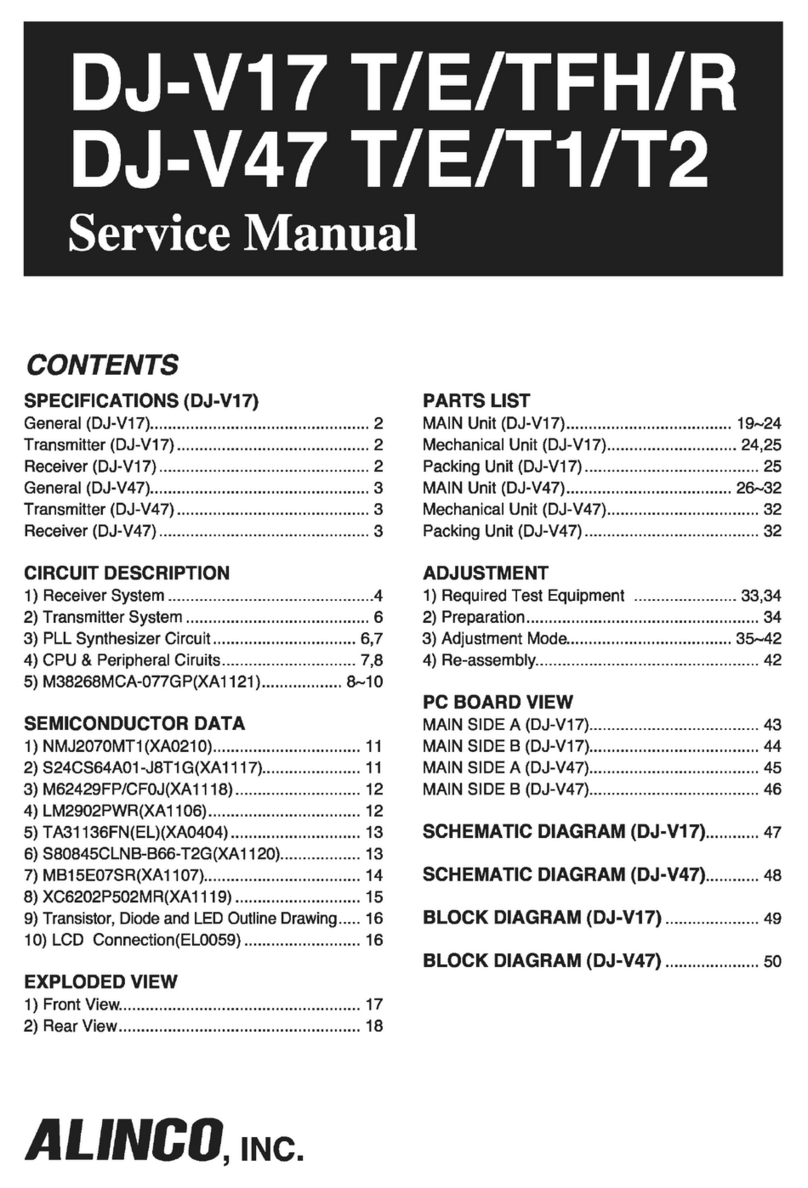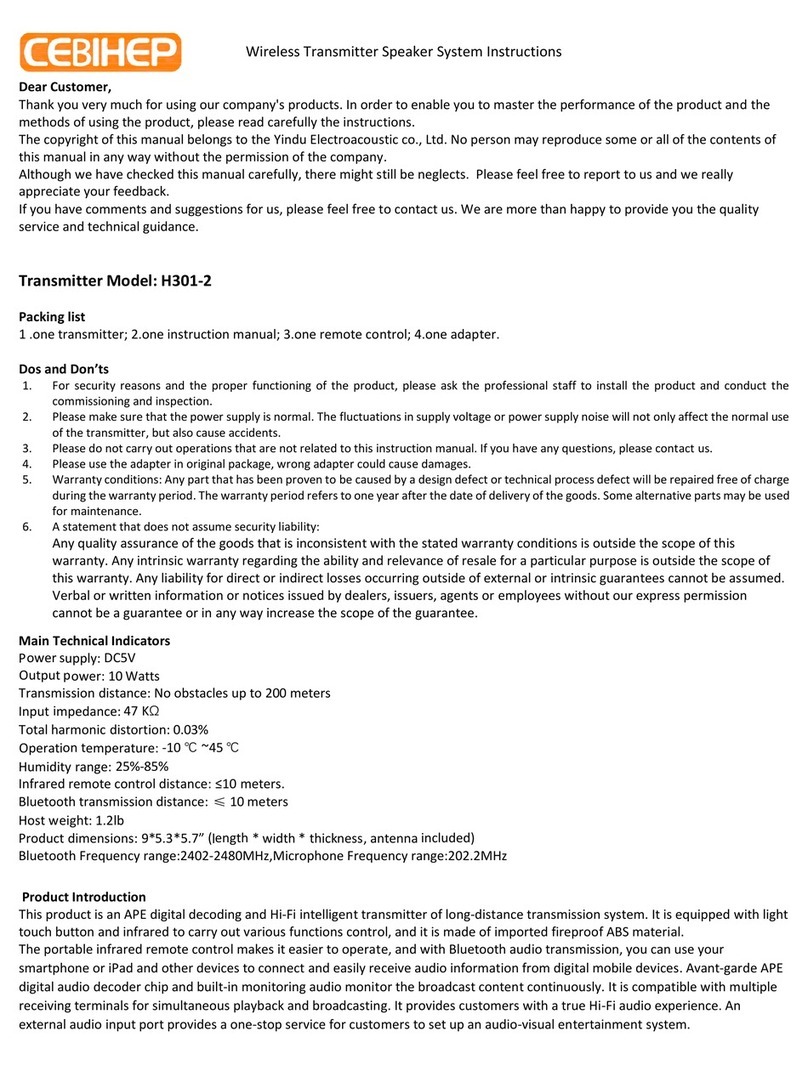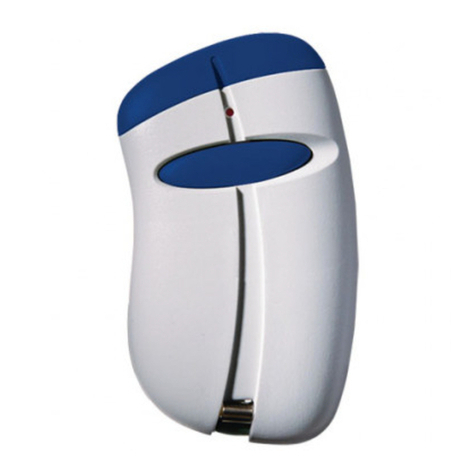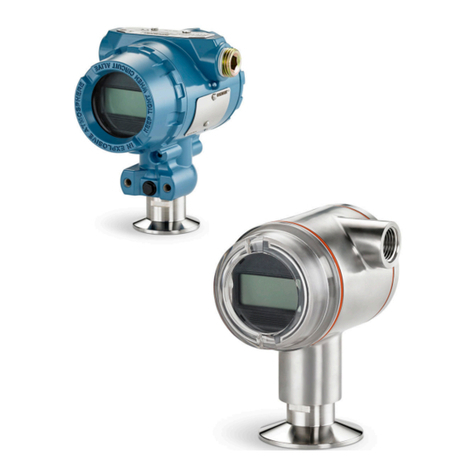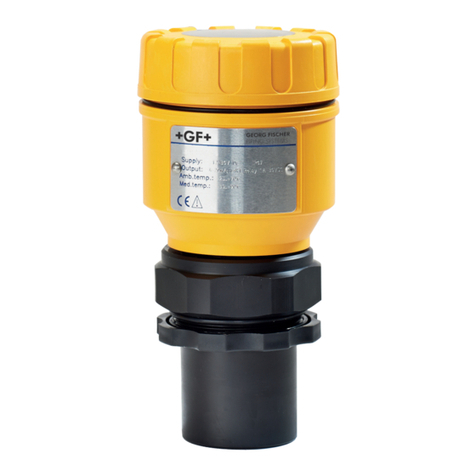Alinco DX-70 User manual

DX-70
Service Manual
CONTENTS
• S P E C IF IC A T IO N S .................................................................................................................. 1
• C IR C U IT D E S C R IP T IO N ................................................................................................. 2
• S E M IC O N D U C T O R D A T A ........................................................................................... 1 2
• E X P L O D E D V I E W ................................................................................................................ 21
• P A R T S L IS T .................................................................................................................................. 2 8
• A D J U S T M E N T ............................................................................................................................. 4 2
• P C B O A R D V I E W .................................................................................................................... 4 9
• B L O C K D IA R A M
.......................................................
.
....................................................... 5 8
• C IR C U IT D IA R A M ............................................................................................................... 5 9
• E D X - 1 ...................................................................................................................................................... 6 5
A L IN C O , IN C

SPECIFICATIONS
1) eneral
Operating mode J3E(LSB,USB). A IA (C W ). F3E(F )
Number of memory channels 100
Antenna impedance 50 Q unbalanced
Power requirement 13.8 V DC ± 15% (11.7 to 15.8 V DC)
Grounding method Negative ground
Current drain Receive 1.0 A max.
Transmit 20 A max,
Operating temperature -10 °C to +60 °C
Frequency stability ± 10 ppm (-10 “C to +50 °C)
Dimensions 178(w) X 58(h) X 228(d) mm
(179 X 71 X 268 mm for projections included)
Weight Approx. 2.7 kg
2) Transmitter
Transmit frequency
coverage
(e.g. U.S. Version)
160 m band
80 m band
40 m band
30 in band
20 m band
17 m band
15 m band
12 m band
10 m band
6 m band
1.8000 to 1.9999 Hz
3.5000 to 3.9999 Hz
7.0000 to 7.2999 Hz
10.1000 lo 10.1499 Hz
14.0000 to 14.3499 Hz
18.0680 to 18.1679 Hz
21.0000 to 21.4499 Hz
24.8900 to 24.9899 Hz
28.0000 to 29.6999 Hz
50.0000 to 53.9999 Hz
HF band
SSB. CW. F 100 W (high)
Approx. 10 W (low)
A 40 W (high)
j Power Approx. 4 W (low)
output
50 Hz
band
SSB, CW. F 10 W (high)
Approx. 1 W (low)
A 4 W (high)
Approx. 0.4 W (low)
odulation
system
SSB Balanced modulation
A Low power modulation
F Reactance modulation

Transmitter (continued)
Spurious emission HF bands Less than -50 dB (-45 dB in 10 Hz band)
50 Hz band Less than -60 dB
Carrier Suppression ore than 40 dB
Sideband suppression ore than 50 dB (at 1 kHz)
aximum F
deviation (default) HF bands ±2.5 kHz
50 Hz band ± 5 kHz
icrophone impedance 2 kfi
3) Receiver
Receiver circuitry Double conversion superheterodyne
Receive frequency range 0.1500 Hz to 30.0000 Hz. 50.0000 Hz to 54.0000 Hz
Intermediate frequency 71.75 Hz (1st) 455 kHz(2nd)
Sensitivity
SSB, CW
(S/N 10 dB)
0.5 to 1.8 Hz 0 dB (1 pV)
1.8 to 30 Hz -12 dB (0.25 (j.V)
50 to 54 Hz -16 dB (0.15 pV)
A (1 kHz,
30%, od,
S/N 10 dB)
0.5 to 1.8 Hz +20 dB (10n V )
1.8 to 30 Hz +6 dB (2 pV)
50 to 54 Hz +6 dB (2 |iV)
F (1 kHz.
3.5kHz, DEV,
S1NAD 12 dB)
28 to 30 Hz -6 dB|i(0.5 |aV)
50 to 54 Hz -10 dBji (0.3 }.iV)
Selectivity
SSB, A (Narrow) 2.4 kHz/-6 dB, 4.5 kHz/-60 dB
SSB(Nartow), CW(Standard) 1.0 kHzy-6 dB, 3.0 kHz/-60 dB
CW(Narrow) 500 Hzy-6 dB, 3.0 kHzA60 dB
A (Standard), F 9 kHz/-6 dB, 20 kHz/-50 dB
Superiors and image rejection ratio ore than 70 dB
Audio output power ore than 2.0 W (at 8 Q, 10% THD)
RIT/TXIT range ±1.4 kHz

ro
CIRCUIT ESCRIPTION
1. Receiver System
1) Filter Unit
a. HF Antenna Input SA501 and R527 are installed in the input part of HF antenna terminal as the
countermeasure against the thunder.
The electric charge of HF antenna is discharged at R527, and when the voltage
becomes over about 300V, the gap of SA501 is discharged so that the receiving
input circuit is protected.
The input signal from HF antenna is passed through the transmission/reception
selecting relay RL513. The followings are prevented in LPF consisting of 1525,
L526, C580, C581 and C582: 2m band image receiving, passing through the First
IF (71,75 Hz) and leaking of the first local oscillating frequency (72~130 Hz) to
the antenna terminal.
b. 50 Hz Antenna Input The receiving signal from the antenna of 50 Hz band is passed through the LPF
for transmission/reception and passed through the transmitting power detection
circuit, then led to transmission/reception switching circuit consisting of D508 and
D509, and to HPF. The signal is amplified about 8dB in Q503. Because the space
noise in 50 Hz band is less than it in HF band, its exclusive receiving preamplifier
is equipped to get high sensitivity.
The receiving signal of 50 Hz or HF is selected in RL514, then after passing
through the attenuator circuit (ON/OFF) of about 20dB consisting of RL515, R528
and R531 the signal is led to the ain unit.
2) Main Unit
a. Front End The receiving signal output from Filter Unit is fed to ain unit through CN2. •
HPF, consisting of L19, L20, C47, C48, C49, C50, C51 and C52, eliminates the
strong radio signal of W band of 1.6 Hz or below. In case of receiving the
signal of 1.6 Hz or below, the sensitivity is controlled by the attenuator in R37 and
BPF1, also the signal is separated into 1.6 Hz, over or below.
5 BPF units consists of 9 filters. Each filter covers the following frequency range.
The frequency of 2.5 Hz or more consists of Chebyshev BPF, and under 2.5 Hz
frequency band is LPF. Two BPF's are installed on the same unit. Not to be
influenced so much, the distant frequency band BPF’s are combined.
-1.6 Hz BPF1
1.G - 2..5 H2 BPF2 1.8 Hz
2.5 - 4.5 Hz BPF3 3.5 Hz
4.5 - 7.5 Hz BPF4 7 Hz
7.5 - 10.5 Hz BPF1 10 Hz
10.5- 14.5 Hz BPF2 14 Hz
14.5- 21.5 Hz BPF3 18, 21 Hz
21.5- 30 Hz BPF4 24, 2B Hz
50 - 54 Hz BPF5 50 Hz

Passing through BPF, the signal turns ON/OFF in the switching diode, D29 and
D30. This preamplifier is the parallel grounded gate operation of Q9 and Q10
(2SK2171), so the unit can obtain a good performance at a high level input signal
with low NF.
The wide range frequency from about 1 Hz to 60 Hz is amplified about 10dB.
This lOdB preamplifier and 20dB attenuator in the Filter unit are combined, then by
pressing RF gain switch on the front panel, one of four steps, -20, -10, 0, or +10dB
is selected.
The LPF, consisting of L52, L53, L54, C103, C104, C105, and C106, prevents the
following first receiving mixer from the local oscillation leaking, and also prevents
the first IF and image of the spurious receiving.
The first receiving mixer consisting of Q10 and Q11 is the balanced mixer, in which
the local oscillating signal is fed to the gate of 2SK2171.
7 he 3rd intercept point is about 20dBm, and local oscillator of about 2V P-P is fed
to the gate. The receiving signal is converted into the first IF of 71.75 Hz.
As the ratio of the spurious interference is decreased in 50 Hz band mode, the
trap of 71.75 Hz consisting of L72 and C107 keeps the ratio of spurious interfer
ence 70dB or more in all band.
b. The First IF Amplifier Circuit FL1: A and FL1: B are the crystal filters of 71.75 Hz. By the combination of two
filters, the unit has the characteristics of the band width of 15kHz or more/3dB and
the value of guaranteed attenuation of 70dB or more. Here the image ratio is
determined 70dB or more (approx. 80dB}. The first IF amplifier circuit of Q12 is
located between the crystal filters to prevent the loss in the front-end and mutual
interference.
The first IF amplifier circuit Q12 decides the sensitivity after passing the mixer.
AGC voltage is applied to the second gate.
c. The Second ixer Circuit, The Second Amplifier Circuit
DB (Double Balanced ixer) consists of L14, D7 and L16. The signal is passed
in the opposite direction while receiving or transmitting in this DB . Approximately
OdBm is as the second \ocat oscitaVing \evel, and the third IP is approximately
lOdBm.
The receiving signal (71.75 Hz) and the second local oscillating frequency
(71,295 Hz) is mixed, and unwanted signal is eliminated in LPF consisting of L17,
L73 and C36, then the signal of 455kHz is generated. After passing through the
switching diode D8, the signal is amplified in Q22. The source of Q22 is controlled
by the output of the noise blanker circuit.
d. IF Filter
After passing through the transmission/reception switching diode D9, the signal is
led to one oi three ceramic filters of 455kHz. The selectivity is decided here
except CW narrow.
SSB, A -NARROW FL3(CFJ455K5) 2.4kHz/-6dB 4.5kHz/-60dB
SSB-NARROW, CW FL2(CFJ455K8) 1.0kHz/-6dB 3.0kHz/-60dB
F , A FL.4(CFW455G) 9kHz/-6dB 20kHz/-50dB
Each filter has 4 switching diodes (D3-D48) in front and rear to isolate the filter.

The isolation is required the value of guaranteed attenuation of each filter (approx.
70dB) or more. The diode connected in parallel in front and rear of no used filter is
short and the diode connected in series is open. The combination of open and
short is used to get the high isolation.
The modes, transmission/reception and wide/narrow of this filter are selected by
Q36-Q46, D79, D80, D82, D83, D84.
e. The Second IF Amplifier Circuit
f. Demodulation Circuit
g. CW Audio Filter
After passing through the filter, the signal is led to the transmission/reception
switching diode D49, and amplified in Q23 and Q24, then buffered in Q25.
The AGC voltage is applied to the second gate of Q22, Q23 and Q24.
The output level of 025 is fixed because the AGC voltage is added to the receiv
ing signal.
This output signal is used for the demodulation in SSB, A and CW modes and
AGC detection.
In the F mode, after passing through the transmission/reception switching diode
of D49, a part of receiving signal is fed to 1C7( C3357) from C221, then it is IF-
amplified and demodulated. C214 is connected in parallel to the feedback resister
R182, and the resister is de-emphasized. Even in the F mode, Q23, Q24 and
Q25 are active, also AGC is operated.
In SSB and CW modes, the following local oscillating frequency is supplied from
PLL unit to IC3 balanced mixer, then the signal is demodulated.
The receiving signal is fed to Pint, and local oscillation Pin3, then picked up the
demodulation output of approximately 100mV from Pin7.
USB 456.5kHz +IF SHIFT
LSB 453.5kHz +IF SHIFT
CWU 455.8kHz +1F SHIFT
CWL 454.2kHz +IF SHIFT
The output is led to the switching circuit of each mode, and to the CW audio filter.
In A mode, the signal is detected in D51, then led to IC5.
In F mode, the signal is demodulated and de-emphasized in above-mentioned
IC7, then led to IC5.
IC4 is the active filter, which consists of the combination of low-pass filter and high-
pass filter in the operational amplifier. It has the band width of about 600Hz (-6dB)
centering the trequency of about 800Hz.
h. AF, AGC Time Constant Selection
1C5 is the analogue multiplexer which has 2 circuits with 4 contact points, and
switches the demodulation output in every mode and AGC time constant. The
voltage combined in D55 and D56 is input to Pin9 and Pinl 0, then the output of
1C3 (SSB, CW-W), the modulation output of F /A and CW audio filter output
(CW-N) are selected. The voltage of 8V is applied to Pin6 (INHIBIT) when
transmitting, and the modulation output is turned OFF unconditionally.
GO

i. AF Amplifier
The voltage that can pass through the analogue switch of IC5 is very low. The
voltage is amplified approximately 20dB in IC12: B to get higher AF input voltage
to following IC13 (voltage controlled electronic volume). Also a part of this output
is picked up and output to Pin6 of microphone as non-squelched audio output.
This output is used as the terminal of packet, RTTY, SSTV, etc.
j. Electronic Volume, AF Amplifier
IC13 is the dual electronic volume controlled by the voltage.
The volume is controlled by the AF GAIN VR on the front panel. Pin5 is the control
terminal. The value of the attenuation is the minimum when the control voltage is
about 3.4V, and the value is 90dB or more at maximum when the control voltage is
about 3.1V.
One of the circuits is for volume control of the demodulation sound, and the other
for the volume control of the beep and sidetone. The beep and sidetone can be
heard even if the volume is set to the minimum point and sound tone is related with
AF GAIN VR.
The squelch circuit (IC14:A, Q14) controls Pin5. The output of IC14: A activates to
close the squelch when transmitting, so Q14 is turned OFF in D85 to control the
volume of the sidetone.
The receiving sound is fed to Pin6 and applied from Pin7. As for the beep and
side tones, Pin2 is for input and Pin 1 for output. These two outputs are combined
with the inpul of LPF amplifier IC12:A. The high tone noise that is generated in IF
amplifier is decreased by LPF amplifier.
The output of IC12: A is attenuated in R309 and R310 to get the same level with
IC20, and also to decrease the noise. IC20 is the AF power ampliiier which can
get the output of 2W or more (THD 10%) at 8£2 load. The ripple filter consists of
Q51 and C260.
The AGC voltage is supplied one stage to first IF amplifier and three stages to
second IF amplifier. These IF amplifiers consist of 3SK131. AGC voltage is
applied to the Gate2. The IF amplifiers are designed that the gain is changed
linearly corresponding to the AGC voltage.
D53 and D54 are the rectifier, and Q26 is DC amplifier. D50, the anode is set to
about 2V in R176, D110, D111 and R177. Usually AGC voltage is applied 2.4V.
The strong signal rectifies D53 and D54 resulting in DC voltage. Q26 decreases
the AGC voltage.
When AGC-FAST is selected in SSB/CW mode, C205 and C206 are connected
between 5V and AGC line in parallel. The attack time of AGC is determined in
R167 and C206, then the release time is determined in R168 and C206. The
characteristics are "fast attack" and "slow release". In case of AGC-SLOW, the
analogue switch IC6 is turned ON, then R175 and C287 are connected in parallel.
The release time is lengthened because of C287. In case of A , C206 is con
nected in parallel, then the attack time is delayed, which is the average type. D110
and D111 is the thermal compensation of D50.
in receiving A , AGC is the average type not to follow the modulation.

I. S eter, Squelch
The output of Pin 1 and RF meter output are combined in the diode, then it is sent
to the front CPU to display the meter. The output signal of Pin1 is fed to Pin6 of
IC14:A. The voltage of Pin5 is determined by the squelch VR of front unit. Com
paring with this voltage, the squelch is opened or closed.
While the check operation the CPU output decreases the voltage of squelch VR in
front side to open the squelch forcedly. The squelch output controls IC13, at the
same time it is provided to the front unit to light RX LED and led to CPU unit.
m. Noise Blanker Circuit
This circuit eliminates the pulse noise of a car, etc. Because the noise emitting
time is short, in this duration the operation of receiver is stopped to prevent the unit
Irom emitting a noise. The pulse noise is delayed when it is passed through the
narrow band filter, and the emitting time becomes longer. It makes difficult to
eliminate the noise, so it is necessary to eliminate the noise in the earlier stage.
A part of the second mixer output, whose band width is limited, is amplified in Q20,
Q19, 018, and Q16. The signal is detected in D33 and D34, and the AGC voltage
is applied to 019, Q18 and Q16.
The charge time constant of this AGC is determined by R82 and C128, and also
the discharge constant is determined by R81+R82, C128. The voltage of AGC
does not rise suddenly because of the charge constant, so that this voltage is not
applied to almost all the short signals such as pulse noise, but is applied to the
continuous signals such as receiving signal and amplilier gain is decreased.
While emitting the pulse noise, the AGC voltage does not follow the pulse noise,
so the detected voltage is high, then 015 is turned ON in that time.
On the contrary, as for the continuous signal, the detected voltage of D33 and D34
is fixed by AGC, so 015 is turned OFF because of the emitter bias of R85 and
R84.
Namely Q15 is turned ON only the time of the pulse noise, then 021 is turned
OFF. The source of IF amplifier of 022 is biased through R98 and R102 so that
the gain is decreased and the signal is blanked. When the emitter of Q15 is
biased to high, the Noise Blanker is turned OFF.

2. Transmitter System
1) Main Unit
a. icrophone Amplifier The input signal from microphone is amplified by the low noise amplifier 056
through the mic gain VR1. It is possible to bias (8V) the microphone terminal with
R388 for the microphone which needs the power supply, (solder bridge)
In SSB/A mode, The gain of IC21 (approx. 15dB) is determined by R329 and
R328.
In F mode, R330 is connected to R320 in parallel by Q55, then the gain is
increased approximately 34dB. Also the cut off frequency is risen, and the signal
is pre-emphasized and operated as a limitter.
In the SSB/A mode, C345 and R384 are conntected to the feedback circuit by
Q63 when the speech compressor is turned ON. The gain is increased about
15dB, then IC21:B is operated as the limitter.
When the speech compressor is ON, the low frequency is cut by C345.
In F mode, the gain is risen enough, so the speech compressor has no effect.
The output of Pin1 of IC21: B is attenuated in R326 and R325. The subaudible
tone from PLL unit is applied through R325. (When the Tone is ON.)
IC21: A is LPF amplifier that is the Splutter filter in F mode, and it is operated for
speech compressor.
This signal is output to PLL unit as the F modulation, and output to the balanced
modulation of IC2.
The output to IC2 is muted by Q54 in CW/F mode.
b. Balanced ixer !C2 is the balanced mixer, and the carrier is suppressed in SSB mode. To get
more ratio of carrier suppression, the balance adjustment of VR3 and VR4 are
applied.
The carrier is necessary in CW/F /A mode, so the input of Pinl is made unbal
anced by applying the DC voltage to obtain the carrier.
By applying the DC in A /F mode, or by keying in CW mode, the balance is
broken to obtain the carrier wave. VR11 is used for the adjustment of carrier level.
In the A mode, the DC and modulation is added simultaneously. In SSB mode,
the modulation is added by R317. In A mode, D93 is DC-biased and turned ON.
Then the attenuator consisting of R317 and R393 limits the modulation.
c. IF Filter After the output of !C2 increases the impedance in C177 and L77, it is passed
through D49 and led into band limit IF filter. D52 is isolated highly by connecting to
the output in parallel at receiving. In SSB mode, the output is DSB signal. (Double
Side Band)
The filter is switched by the selection of above-mentioned diode switch. The signal
is passed through the following filer in each mode.
SSB FL3(CFJ455K5) 2.4kHz/-6dB 4.5kHz/-60dB
CW FL2 (CFJ455K8) 1.0kHz/-6dB 3.0kHz/-60dB
F , A FL4 (CFW455G) 9kHz/-6dB 20kHz/-50dB
SSB is obtained by eliminati'ng one of side bands of DSB through the filter.

d. IF Amplifier, The Second ixer
After passing through the filter, the signal is led to D37, Q7, and D6, and passed
through the second mixer in the opposite direction of the receiving, then the signal
of 71.75 Hz is obtained. Q6 operates the CW keying.
The voltage of ALC is added to the second gate of Q7.
The local oscillating signal of 71.295 Hz and unwanted signal are eliminated in
FL1: A and FL5. The signal is amplified in 05, passed through FL5, then led to the
balanced mixer of Q3 and Q4.
e. The First Transmitting ixer
This mixer is the balanced type, and the unwanted signals (IF and local oscillating
signal) are decreased. The best operation is selected by biasing the second gate.
To decrease the spurious, the signal is balanced in VR1.
f. Power Amplifier Passing through tihe mixer, the transmitting signal which has the desired transmit
ting Irequency is passed after switching the LPF tor HF band or BPF tor 50 Hz
band. The unwanted signal and especially the leak of local oscillating signal is
decreased as less as possible.
The signal is amplified up to 0~3dBm in Q1. T notch filter consists of C1, C2 and
11. It is tuned to approximately 44 Hz while using 50 Hz band to decrease the
spurious signal. Then the signal is supplied to PA unit.
2) PA Unit
a. Power Amplifier
The signal input to PA unit is amplified up to approximately 100mW. The idling
current of 0601 flows about 100mA during transmitting as A-class amplifier. The
frequency characteristics are compensated by feedback, besides connecting the
capacitor to emitter resistor in parallel.
The signal is amplified up to 10W in Q602 and Q603.
PA amplifier is the wide band range from 1.8 Hz to 50 Hz
The idling current flows 100mA (adjusted in VR601), and the amplifier is the push-
pull type.
D601 is connected to Q602 and Q603 thermally, and the idling current is compen
sated for temperature. This output is switched at RL601 in 50 Hz, then supplied
to filter unit.
b. Final Stage Power Amplifier in the final stage amplifier circuit consisting of Q604 and Q605 (2SC2904), the
idling current of about 300mA is flowing. The base bias is made by Q606. D604
and D605 are connected to 0604, 0605 and Q606 thermally, and the idling current
is compensated for temperature.
The feedback circuit, consisting of R621, R622, R623, C633, R627, R628 and
C637, makes the gain flat in the wide range of 1.8 Hz~30 Hz.
The 100W output is led to filter unit.
The collector cun'ent of 0606 and Q607 is detected by using FB606 and L611.
Then led to the main unit.
U l

c. Fan Control
The heat of Q606 and Q607 is detected by the thermistor TH601, and the fan is
controlled. While transmitting, the resistance value is decreased by the rising of
the temperature, then the voltage of inverting input terminal of IC601A/B is de
creased. Non-inverting input is applied with the voltage corresponding to the
temperature. When the temperature goes up to about 50°C or more and the
compared voltage becomes lower than the inverting input voltage, Q607 is turned
ON by the output voltage of comparator, 10601: A. Then the fan starts turning at a
low speed by the value of series resistor (R639).
When the temperature rises more and the voltage becomes much lower than the
compared voltage IC6Q1: B, Q608 is turned ON. Then R639 is turned OFF and
the fan turns at a high speed according to the value of series resistor of R640 to
decrease the compared voltage of IC601: A.
When the temperature goes up to about 100°C and the voltage is decreased
further lower, IC601: A supplies again, then R639 and R640 are connected in
parallel to turn the fan at a higher speed. Although ordinary PDWN is pulled up to
14V by R637, the power output is set to LOW because both cathode terminals of
D608 become LOW when the fan turns at a high speed. Then the signal is sent to
the main unit as the control signal for power down at high temperature.
As the compared voltage of IC601: B is decreased in D611 while receiving,
IC601:B does not work if the temperature does not go up higher than it while
transmitting. The temperature, at which the fan turns at a middle speed or more, is
higher than it while transmitting. At high temperature, fan's turning speed comes
down whiie receiving.
d. Protection Circuit For the protection of the final power amplifier, the followings are equipped:
SWR detection
Protection against over current
Power down circuit for the temperature detection
e. CW Keying Circuit As the base voltage of main unit 049 goes down to LOW by CW keying, the
voltage is supplied to collector. This output controls all of the circuit operation by
CW keying.
The collector output of 049 is passed through D95, VR11 and D93, and the
balance is broken by applying DC voltage to the balanced mixer to generate the
carrier. VR11 determines the CW waveform of rise and fall by adjusting the carrier
level in R285 and C248.
At the same time Q48 is turned ON to turn OFF Q6 for keying isolation. C244
makes the OFF time of 06 longer not to influence the keying waveform.
The voltage is applied to IC17: B Pin5 in D95, and the output of Pin7 turns 046 ON
to set PTT line to LOW in D73, then the unit enters the transmitting mode. The
capacitor (C246, C247) is connected between Pin5 of IC17: B and the ground.
The holding time of transmitting is determined according to the discharge time
constant. BK1, BK2, and BK3 are the voltages tor the setting of 3*bit break-in time
constant. 8 stages voltage is obtained by the combination of the resistors R269,
R270 and R271.
In the Full Break-in mode, all of BK1, BK2 and BK3 are set to LOW, in the Semi
Break-in mode, one of BK1, BK2, or BK3 is applied the voltage.

When all of the breakers are applied the voltage, it is used as the shortest time
constant.
When in the full break-in mode, all of the voltages of BK1, BK2 and BK3 are low
level, and Q47 is turned OFF. Therefore only C246 is the very short discharge
constant, it is the full break-in mode with short transmitting time. One of BK1, BK2
and BK3 is supplied the voltage, and Q47 is turned OFF, then connected to C247
and C246 in parallel. The discharge time constant is longer, and it is the semi
break-in time constant.
There are 7 stages of the voltage in the semi break-in mode according to the
output voltage of BK1, BK2 or BK3. This is applied to the compared voltage of
IC17: B, then the discharge time constant is changed. Namely when the voltage is
applied to all of BK1, BK2 and BK3, the time constant is the shortest.
When the break-in mode is set to AUTO, BK1 only is supplied, and the compared
voltage of IC17:B is controlled by the output voltage of IC17: B.
In the AUTO mode the keying output is emitted by one-shot multivibrator consist
ing of IC18A aod B whenever the key is pressed. Therefore the average value ot
the output voltage of IC18: A is in proportion to the average speed of keying. To
obtain the average voltage in R281, C245, etc., integrate the voltage. Then this
output is D/C amplified in !C17:A, and provided as the compared voltage of keying.
D97 is used for OFF in the AUTO mode. When the AUTO mode is in the LOW
level, the voltage charged in C245 is short, then the operation in AUTO mode is
stopped.
D107 and R360 are used to get up speed rising when the keying is started. D92
and R280 determine the discharge time constant. While receiving the time
constant is prolonged.
The selection of transmission/reception follows the keying speed from 30 letters/
minute to 200 letters/minute.
The transmitting mode is held between letters, and the unit returns to receiving
mode between words.
f. Power Control, ALC Circuit The forward wave voltage in proportion to the transmitting power obtained in filter
unit is inverting-input to IC8A, and inverting-amplified. Non-inverting input is
applied the voltage, and the output voltage is shifted by the non-inverting input
voltage.
ALC line is applied the voltage of about 2.7V beforehand, and the ALC voltage is
supplied to the second gate of the amplifier.
When the forward wave voltage is detected, the output voltage of IC8: A is de
creased. If it is about 3V or below, the ALC line voltage is decreased by D63.
VR7 is used for the adjustment of 100W. When the unit is switched to 50W by S i,
Q27 is turned ON and VR5 is connected in parallel to decrease the voltage, then
the unit is adjusted to 50W.
In A mode, R195 is connected in parallel to decrease the voltage up to about
40 W.
In the iow power mode, R191 is connected in parallel by setting to LOW, and the
voltage is decreased.
029 and VR8 are used for the adjustment to get the required power of about 10W
in the matching operation of external automatic tuner. (The required power
depends on the tuner.)
When the value of SWR is high, the reflected wave voltage turns Q28 ON to
decrease the power. The unit is operated when the SWR is about 3 or more.

Compared with the forward wave detection power in HF band of 100 W, the
forward wave voltage in 50 Hz band of 10W is set to higher a little.
In SSB mode, "fast attack" is obtained by D63, and the release time of "slow
attack" is obtained by C222 and R130. In A mode C221 is connected in parallel
by Q30, and the unit is operated in near the average value.
g. Over Current Protection Circuit
The final stage collector current which is detected in PA unit is differential-amplified
in IC8: B. The output voltage is decreased according to the increase of the
current. Then ALC line is fallen by D63 and the output power is decreased. The
operational point is decided in VR6.
h. RF eter Circuit, ALC Indication
The forward wave is amplified in IC9: A to obtain the meter output voltage.
The peak is held in D70, R223 and C223, and the meter swings smoothly.
eter output voltage and S meter output voltage are switched in D71 and D86
automatically.
ALC voltage is inverting voltage amplified in IC9: B.
This output is applied to the base of Q31, then sent to front unit for the detection of
transmission/reception and lighting the transmitting LED. The LED brightness is
changed according to the ALC voltage.
i. Sidetone Circuit The comparison frequency of the second local oscillator in PLL unit (65kHz~
85kHz) is divided by 10 in IC714, then led to the main unit. In addition the fre
quency is divided by 10 in IC19 of the main unit to obtain the sidetone of 650Hz~
850Hz. The comparison frequency of the second local oscillator is changed
according to the CW offset setting. To relate with the sidetone, comparison
frequency is about 100 times the CW offset. IC19 Pin2 is controlled by Q65 at CW
keying. The time constant is delayed not to give the influence to waveform of the
sidetone.
The following active filter Q50 makes the square wave to sine wave to obtain
better sound. The rise/fall wave of the sidetone is generated by keying controlling
the bias of base and emitter.
j. Tune Circuit When using the external automatic antenna tuner, this circuit controls the matching
start signal and the operation of the unit during tuner matching.
When the tune operation is started, the Tune voltage is supplied to operate the
one-shot multivibrator in IC18: C, D. The voltage of about 8 V is applied to outside
for a fixed time through Q52 as the start signal. In the other hand, Q53 supplies
the tune voltage of sink output, it becomes LOW while tuning. (For the transceiver
made by ICO , KENWOOD).
As soon as the tuner receives the tune start signal, the tuner provides it as the
tuning signal. (TKEY terminal)
CPU observes the TKEY terminal, and keeps the unit in TUNE mode indicating
that the tuner is operating while it is in the LOW level. CPU releases the TUNE
mode when TKEY terminal is in LOW for 20 seconds or more. In the Tune mode
the unit transmits a signal in A mode, the microphone output is muted, then the
carrier is kept on outputting about 10W (adjustable).

k. Regulated Power Supply Circuit
ICt1 is the BV Regulated Power Supply Circuit. T8V that is necessary tor trans
mitting is made in 033, and R8V that is necessary (or receiving is made in Q35.
IC10, 032 and 034 control the transmission/reception. When PTT line is con
nected to the ground through the microphone terminal or CW keying output (Q46),
H level is supplied from IC10: A and it is led to CPU of front unit to detect the
transmission/reception switching.
IC10: C delays the rise of receiving in R227, C224 and D62 and controls in Q32
and Q33.
While receiving, the current is flowing from 13.8V through R230 and D75, then the
base voltage Q33 is approximately 8.7V, and the emitter output is just 8V.
While transmitting, the base voltage of Q33 is OV because Q32 is turned ON, and
R8V is not provided.
While transmitting R8V is short by D77, and it makes the charge voltage such as
electrolytic capacitor discharge momentarily not to remain R8V.
As for 035, as same as R8V the current is flowing from 13.8V through R230 and
D75, then the base voltage of Q35 is approximately 8.7V and the emitter output is
just 8V while receiving. While transmitting, the base voltage is OV because 034 is
turned ON, and T8V is not provided.
While transmitting T8V is short by D77, and it makes the charge voltage such as
electrolytic capacitor discharge momentarily not to remain T8V.
After delayed the transmitting rise time in IC10:B, the.signal is inverted in 1C18:D,
then T8V is controlled in 034.
When Pin8 IC10:A is supplied the voltage, the unit enters PTT lock mode without
changing the output of PinlO even if the PTT line is connected to the ground.
I. ode Voltage, Function Control
(BPF/ LPF Selector)
The enable terminals of IC15 and IC16 select the signal ENX or ENY by using
IC24 and Q62.
The data from CPU (DAT2) consists of 16-bit serial data, two 8-bit shift resistors
are connected in series.
IC22 and IC23 control the band selection, ON/OFF of preamplifier, ATT, power, TX
mute function,, etc. They are operated in Low level.
IC15 controls the ode voltage, and IC16 controls filter, AGC, Break-in, PTT lock,
and Noise blanker. The voltage o1 every mode (USB, LSB, A , CW, CWU, CWL,
F , TUNE) turns ON 041, Q42, 043 and Q44 to supply 8V .
m- LPF HF supplied from PA final stage eliminates harmonics through LPF of filter unit.
Input/Output of this filter is switched by the relay, and Input/Output of unused filter
is short at the relay contact.
LPF control is used the BPF control voltage of the main unit.
Every LPF consists of Chebyshev filter, and double or more harmonics are
attenuated about 40dB or more.
LO ~ 2.5 Hz BBO, BB1 1.8 Hz band
L1 2.5 Hz~4.0 Hz BB2 3.5 Hz band
L2 4.0 Hz~7.5 Hz BB3 7 Hz band
L3 7.5 Hz~14.5 Hz BB4, BB5 10, 14 Hz band

L4 14.5 H2~21.5 Hz BB6 18,21 Hzband
L5 21,5 Hz~30.0 Hz BB7 24,28 Hz band
The transmitting signal, whose spurious is eliminated by passing through LPF, is
led to power detection circuit and supplied to HF antenna terminal passing through
the selection relay.
n. 50 Hz Transmission/Reception Selector
50 Hz band performs the transmission/reception selection by the diode of D508
and D509. It is supplied to antenna terminal of 50 Hz through LPF.
Both D508 and D509 are turned OFF while receiving, the receiving signal from the
antenna terminal is passed through LPF (L520, L521, C570-C574, L518, C565)
and HPF (L516, C562~C564), then amplified in 0503.
0501 and 0502 are turned ON while transmitting, and D508 and D509 are turned
ON then the transmitting output is passed.
The antenna input of receiving circuit is short because D509 is turned ON. Also as
the parallel resonant circuit consists of L518, D508, etc., the transmitting signal
does not influenced.
o. Power Detection Circuit
The each power detection circuit is equipped with HF band and 50 Hz band.
The harmonics are sometimes generated depending on the using diode in the
detection circuit. LPF makes the standing wave, so the circuit is located before the
LPF in 50 Hz band whose spurious specification is severe, and after LPF in HF
band.
From now on the operation in HF band is shown, and in 50 Hz band the operation
is the same.
L534 is 10-turn bifilar of toroidal core (twisted pairs of AWG). Therefore the both
sides are 20 turns with center tap.
Piercing the center hole of the core means the same with 1 turn. So the trans
former is 1:20.
Therefore R508 is applied the voltage (forward wave voltage) according to the
output voltage, and R509 is applied the voltage (reflected wave) according to the
reflected power. The output power and reflection detect the power to control the
power in the main unit.
p. Dial Rotating Detection The puise generated by the rotation of the main dial is eliminated the chattering in
IC1001: A, B. IC1001: A and B are the Schmitt triggers by the feedback from the
output.
The rise and fall of each output is differentiated in !C1002:A, C, so the pulse
number is doubled. Then it is 4 times the pulse number because of synthesizing in
IC1001: C.
To find the rotation direction, it is detected in 1C1002: B and IC1003 and fed to
CPU. As S1002 generates 50 pulse at 1 rotation, what is input to CPU is 200
pulse/rotation, and 5kHz/rotation in 25Hz step.
The main dial rotates very fast and generates so many pulses. The pulse is
divided in IC1004, and the pulse number is stored as the 6-bit binary digit by each
dividing output. At a high speed rotation the frequency is forwarded by counting
the pulse number stored in IC1004, then the process is finished, the pulse number

c»
3) Front Unit
a. Power Switch
b. Power Supply
c. Dimmer Circuit
d. LCD
e. Others
stored in IC1004 is reset by the output from CPU.
The dial rotation pulse is charged in D1016, R1022 and C1010, and the average
voltage according to the speed is obtained. When the dial rotation speed is fast,
the frequency step per pulse is four times that at normal speed.
When SW1001 is pressed, Q1001 is turned ON, then the contact of RL602 in PA
unit is turned ON to supply the voltage of 13.8V to the front unit. Once the CPU
starts operation, the output from PCONT of CPU turns Q1006 ON to hold ON the
relay of RL602.
When SW1001 is kept pressing while the power is ON, the signal is detected in
PSDET, and the 01006 is turned OFF to cut OFF the power supply.
1C1007 is the regulated power supply of 5V which has the output for CPU reset.
IC1006 is the regulated power supply of 8V which generates the required voltage
for IF shift and volume control.
When the power supply is cut OFF, the output of regulated power supply of 8V is
increased first, and it is detected in D1018 and IC1002:D, then sent to CPU. In
CPU the data is stored in the EEPRO of IC1005 before the output of regulated
power supply of 5V is decreased and the unit is reset. D1019 and C1002 are used
to hold the output voltage of 5V by keeping the input voltage of 5V regulated power
supply as long as possible.
The regulated power supply ol about 10.5V consists of Q1003, Q1004 and Q1005.
Q1003 supplies about 10.5V when the DI output from CPU is 5V.
In CPU unit, DI is the pulse output, and it switches ON/OFF of the output of
about 10.5V.
At full lighting the output from CPU is fixed to 5V. In ’'LP4" mode the duty is 80%
and in "LP 3 " mode the duty is 60%. In this way the brightness is changed by the
duty in Q1003.
Q1003 is supplied the current by turning ON/OFF. At the maximum the brightness
is the lightest, and the duty is decreased according to the dimmer, then the power
dissipation is decreased. The dimmer can be operated by the small transistor.
The maximum brightness is 10.5V, and it is set to under the regulation voltage
(5.3V x 2) to prolong the life of the lamp. The rush current when the lamp is turned
ON is in pulse mode to decrease the load on the lamp.
The indication such as frequency that is required the speed is performed by the
CPU itself, and the other indications are performed by the LCD driver of 1C1009.
The LCD indication employs the frame frequency of about 128Hz, 1/2 DUTY and
1/2 bias.
X1001 is the ceramic resonator of 8 Hz selected not to enter the amateur band in
the harmonics relations.
When the power is ON, the voltage is supplied from Y2 and Y3, to detect whether

it is connected to the outputs DB0-DB6 or not, then the destination is determined.
The currents in YD and Y1, and between DB~DB6 are scanned to detect which
switch on the front panel is pressed.
The both sides of RIT VR are applied 5V, and the location of VR is detected by the
voltage of A/D input terminal.
In the Receiving frequency monitor Q1019 is turned ON by the ONI output from
CPU, the squelch setting voltage programmed by turning the knob on the front
panel is decreased forcedly. Then the squelch is open forcedly without any
relation with VR position.
The output from the main unit (RTXC) lights the LED according to the change of
the ALC voltage. The output cannot be supplied as it is, so it is changed to ON/
OFF signal in Q1009.
Q1011 is the squelch output from the main unit, and it lights RX LED.
4) PLL Unit
Summary The followings are performed in PLL unit:
The generation of carrier signal
The generation of the first and second local oscillating signal
The generation of sidelone CTCSS
Adding the F modulation
aking the power supply of 5V
Details (1) There are 3 kinds of power supply as follows:
The voltage of 13V passed through the switch
The voltage of 8V made in the AIN unit
The voltage of 5V made in the PLL unit
Power supply depending on the ODE comes from the main unit.
(2) First the reference signal of 30 Hz is generated in X701 and Q701 according
to the constant of TC701 and L702.
(3) Secondly the signal of 9.420 Hz +/- 1.5kHz is generated by the voltage of
D706 in X702, 0721 and Q722.
(4) Thirdly the signal of 9.875 Hz +/- 1.5kHz is generated according to the
constant of TC702-TC704, C807, C809, C810, C811 and C812 in Q725 and
Q724.
(5) The frequency of 9.875 Hz is changed according to the ODE, transmission/
reception.
[Transmission/Reception of LSB]
CN701 Pin21 (LSB) is applied the voltage of 8V and the signal is passed through
D714, then results in the frequency of 9.8735 Hz according to the constant of
TC702 and C812. Also (LSB) 8V is passed through D718, and the voltage is
applied to Q723 to emit the carrier signal.
[Transmission/Reception of USB]
CN701 Pin26 (USB) is applied the voltage of 8V and the signal is passed through
D711, then results in the frequency of 9.8765 Hz according to the constant of
TC704 and C807. Also (LSB) 8V is passed through D717, and the voltage is

applied to 0723 to emit the carrier signal.
[Reception of A /F /TUNE]
CN701 Pin20 (F ) or CN7Q1 Pin22 (AT) is added the voltage of 8V and in the F
mode the signal is passed through D708, then results in the frequency of
9.875 Hz according to the constant of TC703 and C811. 0723 has no voltage,
and carrier signal is never emitted.
[Transmission of A /TUNE]
CN701 Pin22(AT) is applied 8V and results in the frequency of 9.875 Hz accord
ing to the constant of TC703, C811.
The voltage of 8V from CN701 Pin23 (T8V) is passed through D718 to add the
voltage to Q723, then the carrier signal is emitted.
[Transmission of F ]
CN701 Pin20 (F ) and CN701 Pin23 (T8V) are added the voltage of 8V , the
Q729 and Q733 are turned ON, 8V voltage of CN701 Pin20 (F ) is passed
through D708, 0733 and D714, then results in the frequency of 9.8735 Hz
according to the constant of TC702 and C812. Here F is passed through AT and
R814 to turn ON C811, however, as Q733 is also turned ON, 0727 is turned ON
and C811 is shorted.
The voltage of 8V from CN701 Pin23 (T8V) is passed through D718, and led to
Q723 to emit the carrier signal.
The voltage of 8V from Q733 turns ON the analogue switch of IC715.
The modulation signal is passed through R798, IC715, R796 and C801, and it is
F -modulated in VC02.
[The Transmission of CWU/CWL]
CN701 Pin24 (CWU) or CN701 Pin25 (CWL} is supplied the voltage of 8V, then it
is passed through D716, D732, Q716 (because Q729 is ON) and R814, then
results in the frequency of 9.875 Hz according to the constant of TC703 and
C811.
Although here CWU tries to turn C810 ON or CWL tries to turn C809 ON, it can not
be done through 0715 because Q729 is also turned ON.
[The Reception of CWU]
CN701 Pin24 (CWU) is supplied the voltage of 8V, passed through D712, then
resulting in the frequency of 9.8758 Hz of frequency according to the constant of
TC703 and C810. Also the voltage of 8V from CN701 Pin24 (CWL) is passed
through D716 and D717 to the Q723, then the carrier signal is emitted.
[The Reception of CWL]
CN701 Pin25 (CWU) is supplied the voltage of 8V, passed through D712, then
resulting in the frequency of 9.8742 Hz of frequency according to the constant of
TC7G3 and C809. Also the voltage of 8V from CN701 Pin25 (CWL) is passed
through D716 and D717 to the Q723, then the carrier signal is emitted.
(6) The frequency of 9.42 Hz can be changed only while receiving by the IF shift
volume on the front panel.
The voltage supplied to CN701 Pin14 (SHV) is changed by the IF shift volume, and

the capacitance of D706 is also changed, then 9.42 Hz is changed. The center
frequency of the IF shift volume is determined by VR702.
While transmitting 0715 is turned ON by T8V to eliminate the influence by SHV
and VR 701, then the frequency is decided only by VR701.
In USB CN701 Pin26 (USB) and CN701 Pin 15 (TONS) are supplied the voltage of
8V. As in UT mode TONS becomes the sink, 0735 is turned OFF and USB is
supplied 0V , then Q730 is turned ON and a terminal of R767 is connected to the
ground to decrease the voltage of D706, beside the frequency of 9.42 Hz is
decreased about 300Hz less while receiving and about 100Hz less while transmit
ting than the vaiue in USB mode.
In the same manner, in LSB mode the voltages of CN701 Pin21 (LSB) and CN701
Pin 15 (TONS) are 8V. As in LT mode TONS becomes the sink, Q735 is turned
OFF and D729 is supplied the voltage by R767. Then voltage of D706 is in
creased. Beside the frequency of 9.42Hz is increased about 300Hz more while
receiving and about 100Hz more while transmitting than the vaiue in LSB mode.
(7) The Emission of 455kHz Carrier Signal
The above-mentioned 9.875 Hz signal is input to ixer IC712 Pin6, and 9.42 Hz
signal is input to IC712 PinB. The difference frequency of 455kHz is output from
IC712 Pin3 and sent to the AIN unit from J701 after amplified in Q723. The
Output level is approximately -5dB
(Frequency Relations depending on the ode)
USB{TX RX)
LSB(TX RX) F (TX)
CWU CWL A TUNE (TX)
CWU(RX)
CWL(RX)
UT(RX)
LT(RX)
UT(TX)
LTfTX)
A F (RX) does not output
{”*): While receiving IF Shift Operation (+/-1.5kHz)
(*): IF Shift Operation (+/-1.5kHz)
9.8765 Hz-9.42 Hz (**) =
9.8735 Hz - 9.42 Hz (" ) =
9.8750 Hz-9.42 Hz
9.8758 Hz - 9.42 Hz (*) =
9.8742 Hz-9.42 Hz O =
9.8765 Hz-9.4197 Hz ( >
9.8735 Hz - 9.4203 Hz (') =
9.8765 Hz-9.4199 Hz =
9.8735 Hz-9.4201 Hz ■
456.5kHz (•*)
453.5kHz D
455.0kHz O
453.5kHz (*)
453.5kHz (*)
456.8kHz (■)
: 453.2kHz (*)
456.6kHz
: 453.4kHz
(8) The Second Loca! Oscillating Signal
In VC02 unit, after the frequency of 71.295 Hz is oscillated in 0941 and amplified
in 0949, Q944 and Q945, the signal of approximately 3dB is supplied to AIN unit
through J702 as the second local oscillating signal.
The signal for PLL loop is supplied from Q942 to PLL unit.
The signal of 71.295 Hz is fed to ixer IC711 Pin7 and the signal of 9.42 Hz is
fed to Pin3, so that the deference frequency of 61.875 Hi output from Pin6 only is
picked up by Q711, L712 and L711, and fed to PLL IC707, then locked at
61.675 Hz.
Therefore, by rotating the IF shift volume, 9.42 Hz, and also 71.295 Hz are
changed.
The frequency of 30 Hz is fed to IC707 through Pin1, and it is divided to get the
following frequency as the reference frequency, and also the frequency of

61.875 Hz is divided to get the reference frequency, then these two frequencies
are compared.
The reference frequency changes according to the CW sidetone frequency.
When the sidetone frequency is 650Hz, the reference frequency is 64.655kHz.
When the sidetone frequency is 750Hz, the reference frequency is 75.000kHz.
When the sidetone frequency is 850Hz, the reference frequency is 85.227kHz.
(9) The First Local Oscillating Signal
In the HF mode, the frequency oscillated in VC03 is amplified in Q710 and Q714,
and passed through the switching diode D725 and D726. then band-pass filter and
RL701. The signal of approximately 3dB is led to the AIN unit from J703.
3 VCO's are built in VC03, and it is oscillated under following frequency condi
tions:
150kHz~under 10.5 Hz:
The VCO is oscillated within 71.90-82.25 Hz by D961.TC961 andQ961.
10.5kHz~under 21.5 Hz:
The VCO is oscillated within 82.25~93.25 Hz by D963, TC962 and Q963.
21.5kHz~under 30.0 Hz:
The VCO is oscillated within 93.25-101,75 Hz by D965, TC963 and
0965.
These 3 VOC’s are selected by the serial data of DAT2, CK2 and ENB from CPU.
8 signals from IC716 are reduced up to 3 signals, then VCO is selected by the
switches of VC03, 0962, 0964 and Q966.
When the frequency is 50 Hz, in VC03 the oscillated frequency within 76.75-
80.75 Hz by D961, TC961 and 0961 are synthesized with the frequency of
45 Hz by the DB (Double Balanced ixer) in L729, L730 and D730, then the
frequency within 121.75-125.75 Hz is generated. It is passed through RL701 by
the band-pass filters of L732, L733. L734 and L735 and Amplifier of 0731 and
0716, then the signal of approximately 3dB is output to J703.
The frequency of 45 Hz is generated as follows: The reference signal of 30 Hz
is amplified in 0719 and fed to IC701 Pin3, then one half of the signal is supplied
from Pin5. 3 times frequency of the signal only is passed through the filter L720,
L721 and L722, and fed to the center tap of L729, then led to DB .
The frequency loop of VC03 is locked as follows: VC03 oscillating frequency is
passed through 0712 and input to the mixer 1C709 Pin6, also the signal of 70.65-
70.75 Hz (25Hz step) is fed to 1C709 Pin8. Then the signal of 1.1 -31.1 Hz
passed through the amplifier Q713 and led to PLL 1C702 Pin8 as the difference
signal.
This frequency is locked by the following procedure.
1.1 Hz is added to the digit number of 100kHz or more of the operation fre
quency, and divided to obtain 100kHz. Then the frequency is locked after compar
ing with the reference frequency 100kHz. See the examples as shown below.
Operation Frequency: 1 Hz
—> PLL The frequency fed to IC702 Pin8: 2.1 Hz
Other manuals for DX-70
2
Table of contents
Other Alinco Transmitter manuals
Popular Transmitter manuals by other brands
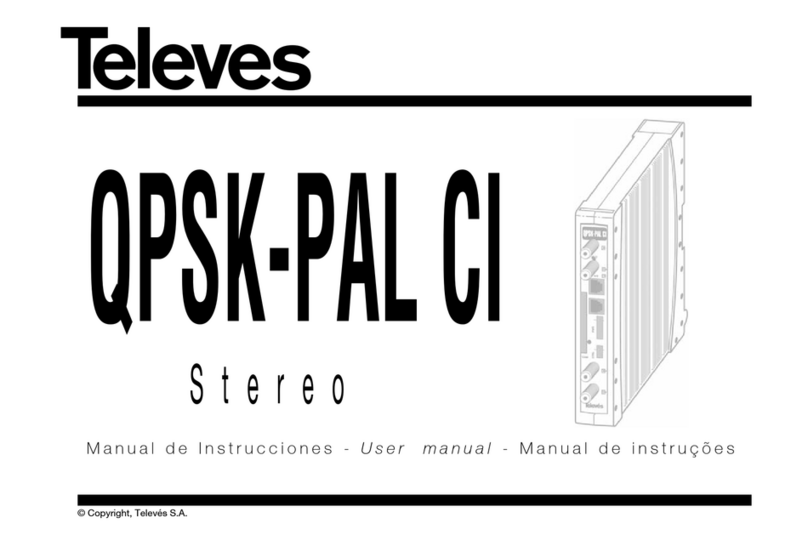
Televes
Televes QPSK-PAL CI user manual
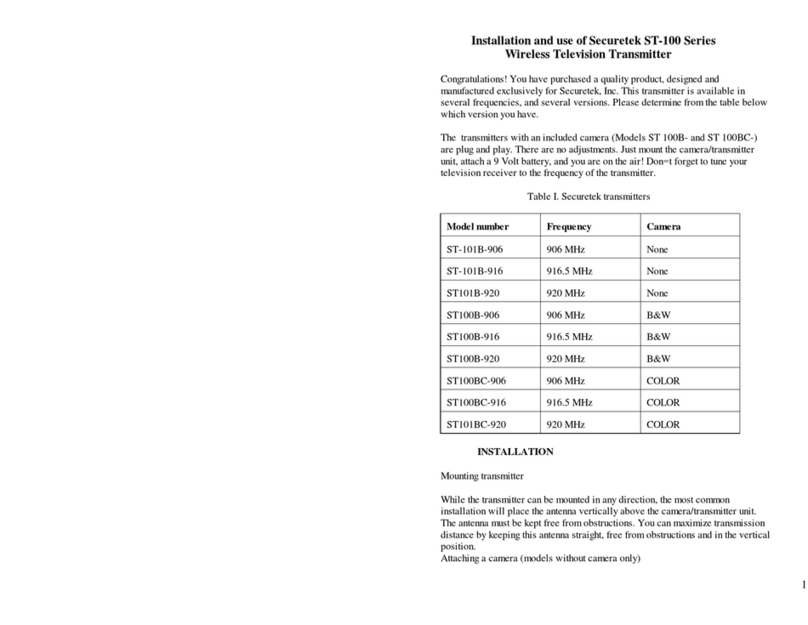
National Wireless
National Wireless Securetek ST-100 Series Installation and User Instruction

ATI Technologies
ATI Technologies D12 EX-IR Series O & M Manual
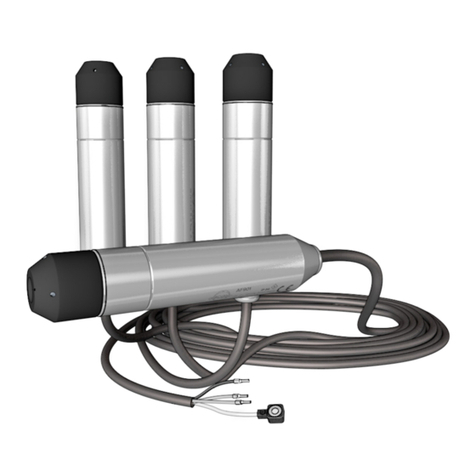
autosen
autosen AF901 operating instructions
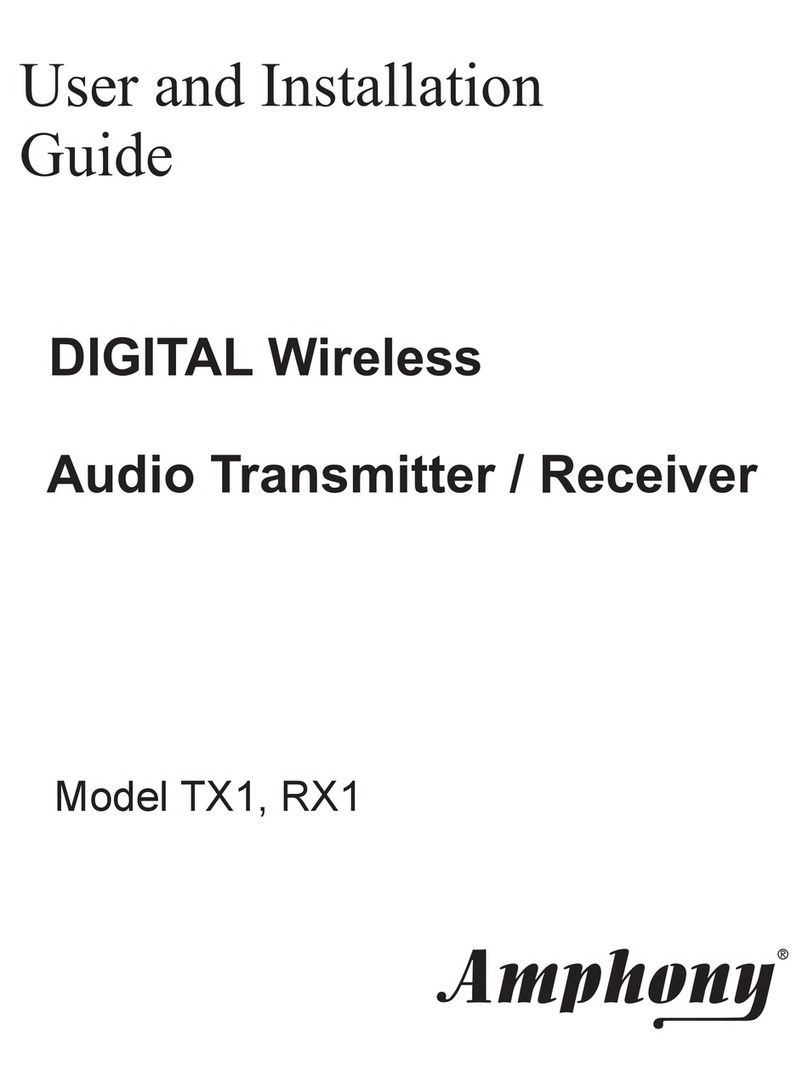
Amphony
Amphony RX1 User and installation guide
Silicon Laboratories
Silicon Laboratories Si4704 Series Programming guide
